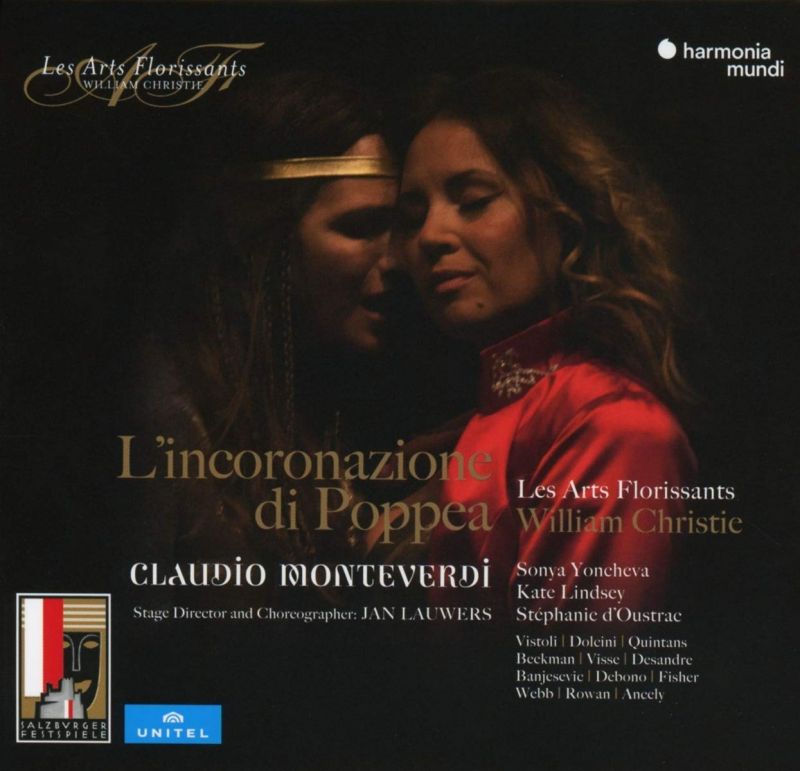MONTEVERDI L’incoronazione di Poppea (Christie)
View record and artist detailsRecord and Artist Details
Composer or Director: Claudio Monteverdi
Genre:
Opera
Label: Harmonia Mundi
Magazine Review Date: 10/2019
Media Format: CD or Download
Media Runtime: 187
Mastering:
DDD
Catalogue Number: HAF890 2622/4

Tracks:
| Composition | Artist Credit |
|---|---|
| (L')Incoronazione di Poppea, '(The) Coronation of Poppea' |
Claudio Monteverdi, Composer
(Les) Arts Florissants ensemble Alessandro Fisher, Lucano, Tenor horn Ana Quintans, Virtue; Drusilla, Soprano Carlo Vistoli, Ottone, Countertenor Claudio Monteverdi, Composer Dominique Visse, Arnalta, Countertenor Kate Lindsey, Nerone, Mezzo soprano Lea Desandre, Amore, Mezzo soprano Marcel Beekman, Nutrice, Tenor Renato Dolcini, Seneca, Baritone Sonya Yoncheva, Poppea, Soprano Stéphanie d' Oustrac, Ottavia, Mezzo soprano Tamara Banjesevic, Fortune; Damigella, Soprano Virgile Ancely, Mercurio, Bass William Christie, Conductor |
Author: David Vickers
Cruelty and violence are explored copiously, but the power-crazed protagonists are unlovable on this occasion. Kate Lindsey’s intensely agitated Nerone has neurotic restlessness and edgy singing that oozes threatening instability – a relentless characterisation that leaves little room for lyrical finesse. Sonya Yoncheva’s ruthless Poppea is not to be trifled with, although towards the end she appears afraid of what she has got herself into but cannot resist the lure of the throne – prioritisation of her determination and thirst for power neglects lighter charm and whispered seductiveness. The closing duet is vibrant and unsettling, is low on intimacy, and is blemished by unsteady intonation.
Renato Dolcini has eloquent gravitas with a hint of the philosopher’s stubborn pomposity but there is dignity in Seneca’s acceptance of destiny (even if the lowest E is lacking). Carlo Vistoli’s Ottone is aptly indecisive and weak, scarcely deserving Ana Quintans’s resolute Drusilla. Stéphanie d’Oustrac’s performance of the haughty Ottavia’s ‘Addio Roma’ is profoundly moving, with time standing still at a long weeping silence before her final utterance. Arnalta’s lullaby ‘Oblivion soave’ is sung with hushed tenderness by Dominique Visse, whereas her last scene of gloating shows the countertenor-in-drag specialist’s extraordinary talent for exaggerated comedy. Marcel Beekman offers ample comic absurdity and an impressively polished high tenor register as Ottavia’s Nurse. Numerous smaller roles are performed with characterful vivacity.
The lucidity of the drama is smudged by over-activity on stage from experimental dancers doing an inordinate amount of experimental dancing, often in various states of undress, and always with one of them at centre stage whirling in perpetual circular motion until the next dancer on the rota gives them a cuddle and relieves them. Characters with no business being on stage lurk persistently without purpose and contradict theatrical sense. Ottone does not disguise himself in Drusilla’s clothes for the attempt on Poppea’s life, rendering the rest of Act 3 inexplicable.
Some of the numerous cuts are obtrusive. For example, lines in the confrontation between Nerone and Seneca are missing, Ottone’s reluctant acquiescence to Ottavia’s blackmail is removed, and so are several passages from his attempted murder of Poppea at the end of Act 2. Drusilla’s heroic self-sacrifice when accused of attempted murder is reduced to a bare minimum and much of Ottone’s courageous interruption to save her is missing – even their trial is removed.
An integral virtue of the production is the prominence accorded to instrumentalists, divided between two onstage shallow pits at the forestage. Numerous continuo players (three theorbos, harp, two viols, cello, dulcian, double bass and two keyboardists including Christie) pay avid attention to what is happening further up on stage. Upper instruments including recorder and two cornettos play sinfonias spiritedly, and occasionally they double the voices – a practice that sometimes works but regrettably distorts the three-part madrigalian lament ‘Non morir, Seneca, no’.
This unadulterated live recording is issued as a small hardback book containing three CDs and a DVD. Whether you want to concentrate on purely musical and textual dimensions using the audio-only format and the libretto or to engage with attributes of the interpretation that emerge more clearly from the visual production, the combination of both is an immersive experience.
Discover the world's largest classical music catalogue with Presto Music.

Gramophone Digital Club
- Digital Edition
- Digital Archive
- Reviews Database
- Full website access
From £8.75 / month
Subscribe
Gramophone Full Club
- Print Edition
- Digital Edition
- Digital Archive
- Reviews Database
- Full website access
From £11.00 / month
Subscribe
If you are a library, university or other organisation that would be interested in an institutional subscription to Gramophone please click here for further information.




